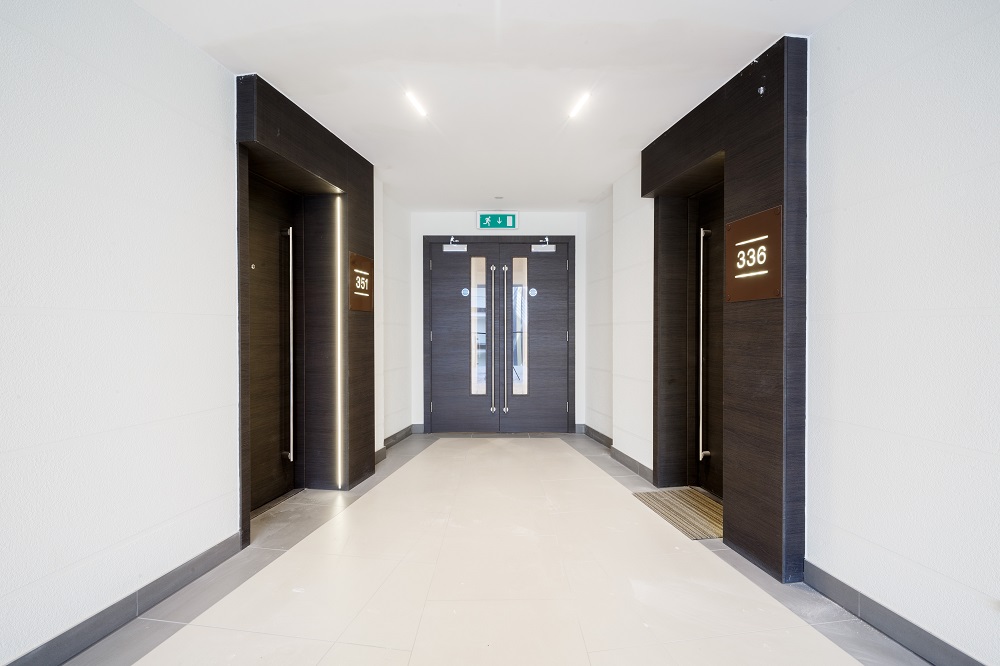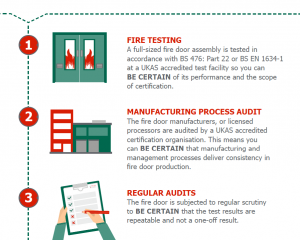- Home
- About BWF Fire Door Alliance
- Fire Door Safety
- Third-Party Certification
- Publications
- News
- Knowledge Centre

Proof of a fire door’s performance is essential in protecting the lives of building occupants. But does a one-off test result mean that fire doors are fit for purpose? No.
To be certain, fire doors should be certified.
Third-party certification of fire doors and doorsets provides crucial evidence that a fire door, when correctly installed and maintained, is fit for purpose and complies with fire door regulations, designed to protect lives and property.
Offering traceability throughout the construction supply chain, including important information about the door’s component parts, fire door third-party certification is a reassuring way to ensure that a fire door will perform as designed in the event of a fire.
Whether you are a landlord, a building manager in the public or private sector, an architect or building designer, knowing that a fire door will perform as it should is critical. A fire test report alone does not prove this.
Fire door third-party certification means that the door manufacturer or processor is audited by an independent third-party organisation to provide evidence that the product is tested appropriately and produced to a consistent standard. This gives verification of product performance and reassurance over consistency and quality.
The British Woodworking Federation (BWF) Fire Door Alliance’s recent survey of people with responsibility for fire door specification, installation, and maintenance across the UK has identified a lack of understanding of fire safety-related responsibilities under the new legislation- finding that almost a third of those responsible for fire doors do not understand fire door responsibility under Building Safety Act.

For BWF Fire Door Alliance members, third-party certification means meeting strict and clear criteria, as part of a robust process:
Wherever a fire door is installed, you need to be sure that it will perform as stated in the event of a fire. Third-party certification is the only way you can be certain that a fire door will meet safety requirements.
You may think that carrying out your own tests on fire doors provides the best evidence of how they will perform. While independent tests provide a gauge as to the performance of the door tested against what the manufacturer states, they only provide part of the overall picture. Without a full audit of manufacturing systems, processes, and the wider supply chain, there is no guarantee over consistency and repeatability – this is crucial regardless of whether you specify one or multiple fire doors.
As the Grenfell Inquiry has clearly highlighted, organisations, and individuals within them whom hold fire safety responsibility, are accountable for the decisions they make over life and building safety. With fire safety regulations becoming more rigorous, especially for high-risk buildings, the ability to provide robust evidence over performance is essential.
Third-party certification is key to achieving fire door traceability and enabling all original documents relating to the door’s manufacture to be sourced. This provides proof of compliance with regulations.
The fire door label
When a product is manufactured or modified by a BWF Fire Door Alliance member, a fire door label, with a unique number, is placed on the top of the door. The purpose of this number is to allow for full traceability of the door by the fire door manufacturer or Licensed processor as well as any certifications related to its specification and production records. The primary label will also show the fire door rating for its minimum tested burn performance (e.g. FD30 for minimum 30 minutes).
This allows the original fire door certificate and specification to be sourced, enabling on-site checks to be carried out against the door’s original standards. If any components need replacing, the documents will also outline the parts compatible with the original certification and test requirements to ensure compliance to the original specification is maintained.
Dependent upon the certification scheme used, the fire door may also have a system of plugs in the back edge of the door to identify its performance criteria.
Under Building Regulation 38 and/or the Regulatory Reform (Fire Safety) Order (RRO or FSO), proof of compliance of fire doors can be requested. For this reason, the specification should be adhered to and only compatible components used, otherwise challenges can arise.
[su_spoiler title=”What fire door regulations do I need to be compliant with?” open=”no” style=”default” icon=”plus” anchor=”” class=””]
There are a number of fire door regulations that may apply to you, depending on whether your fire doors are situated in new buildings or if they are within existing flats and buildings. These include Building Regulations for new builds and the Regulatory Reform (Fire Safety) Order: 2005 (RRO) which applies to modifications to existing buildings and new builds.
Information over fire door regulations in both building types can be found here.
[/su_spoiler]
[su_spoiler title=”As a social housing provider what fire door regulations do I need to comply with?” open=”no” style=”default” icon=”plus” anchor=”” class=””]
There are a number of fire door regulations which may apply to social hosing providers, depending on whether fire doors are situated in new buildings or within existing flats and buildings. These include Building Regulations for new builds and the Regulatory Reform (Fire Safety) Order: 2005 (RRO) for modifications to existing buildings.
Beyond the Building Regulations and RRO, the Homes (Fitness for Human Habitation) Act 2018 and The Housing Act (2004) also apply.
More information over fire door regulations in both building types can be found here.
[/su_spoiler]
[su_spoiler title=”What are my responsibilities for fire doors as a private landlord” open=”no” style=”default” icon=”plus” anchor=”” class=””]
It is the legal duty of all landlords to ensure the safety of building occupants. This means being able to provide evidence that fire safety systems and processes, including fire doors, are fit for purpose.
There are a number of fire door regulations which may apply to landlords, depending on whether fire doors are situated in new buildings or within existing flats and buildings. These include Building Regulations for new builds and the Regulatory Reform (Fire Safety) Order: 2005 (RRO) for modifications to existing buildings.
In addition, the Homes (Fitness for Human Habitation) Act 2018 and The Housing Act (2004) also apply to ensure the property is safe for inhabitation.
Information over fire door regulations in both building types can be found here.
[/su_spoiler]
[su_spoiler title=”What are the differences between fire door regulations in new buildings compared to existing flats and buildings?” open=”no” style=”default” icon=”plus” anchor=”” class=””]
For new buildings or alterations/extensions to existing buildings the Building Regulations apply and ensure that the minimum standards required for construction in the UK are met.
In existing flats and buildings, fire door regulations are governed by the Regulatory Reform (Fire Safety) Order: 2005 (RRO). This highlights that fire risk assessments in all non-domestic buildings including the common parts of flats and houses of multiple occupation, falls to the ‘responsible person’.
You can find further information and detail on fire door regulations for both new build and existing flats and buildings here.
[/su_spoiler]
[su_spoiler title=”If a fire door is third-party certified, do I need a separate fire test certificate?” open=”no” style=”default” icon=”plus” anchor=”” class=””]
No, the third-party certification process for fire doors and doorsets includes testing at a UKAS accredited test facility. These tests demonstrate the fire door’s ability to hold back the spread of smoke and fire as required by UK regulations, so you do not need a separate fire test certificate.
The process also offers further reassurance of the product’s ability to perform, achieved through the manufacturing audit process and ongoing audit tests, which confirm that the manufacturer or processor is consistently producing products to the same standard.
Third-party certification is a robust evidence-led approach to fire door safety, which offers more detailed and reliable information compared to a single, one-off fire test.
[/su_spoiler]
[su_spoiler title=”How do I check that my fire doors meet current standards and regulations?” open=”no” style=”default” icon=”plus” anchor=”” class=””]
To check if your fire doors meet current standards and regulations, a fire door inspection should be undertaken to determine the condition and ability of the fire doors to perform in the event of a fire. More information on fire door inspection and maintenance can be found here.
[/su_spoiler]
[su_spoiler title=”How do I check if my fire doors are certified?” open=”no” style=”default” icon=”plus” anchor=”” class=””]
If a fire door or doorset is third-party certified, you will be able to find a fire door label on the top edge of the door, in the frame or fire door plug. The label will display a unique code enabling the original fire door certification information to be sourced along with information about the fire door manufacturer or processor.
If your fire door does not have a label or plug visible, contact the fire door manufacturer or supplier for further information.
More information on the importance of the fire door label can be found here.
[/su_spoiler]
[su_spoiler title=”I have a global assessment, do I need third-party certification?” open=”no” style=”default” icon=”plus” anchor=”” class=””]
A global assessment, or field of application report, is generated from the product fire test evidence that the assessment or report is to cover. They often form part of the third-party certification process but can be a standalone document. However, these documents are usually time limited and need to be reviewed and reissued by the issuing body on a regular basis.
They are also not supported by manufacturing process or testing audits, which are key components of third-party product certification schemes.
[/su_spoiler]
[su_spoiler title=”How do I find a manufacturer or supplier of third-party certified fire doors?” open=”no” style=”default” icon=”plus” anchor=”” class=””]
To find a manufacturer or supplier of third-party certified fire doors and doorsets, use the BWF Fire Door Alliance find a supplier search here.
[/su_spoiler]